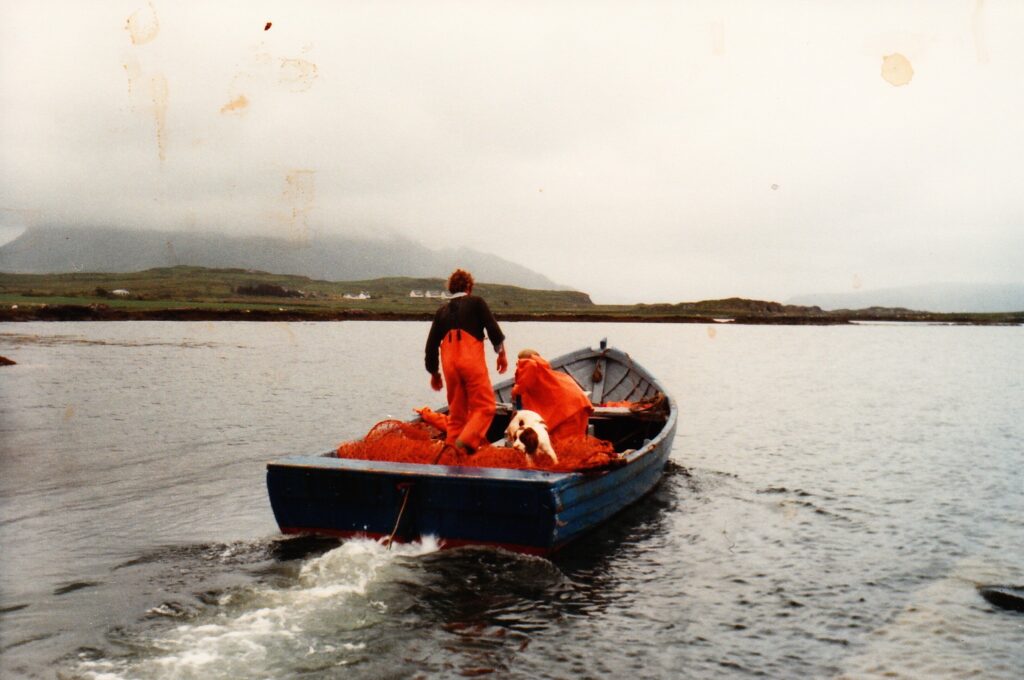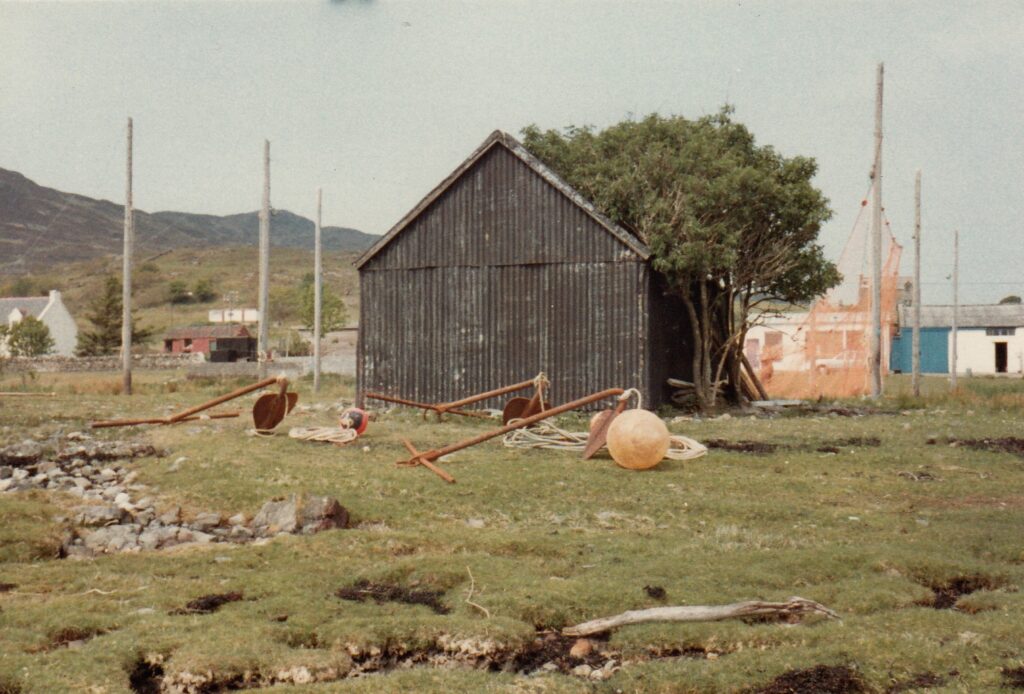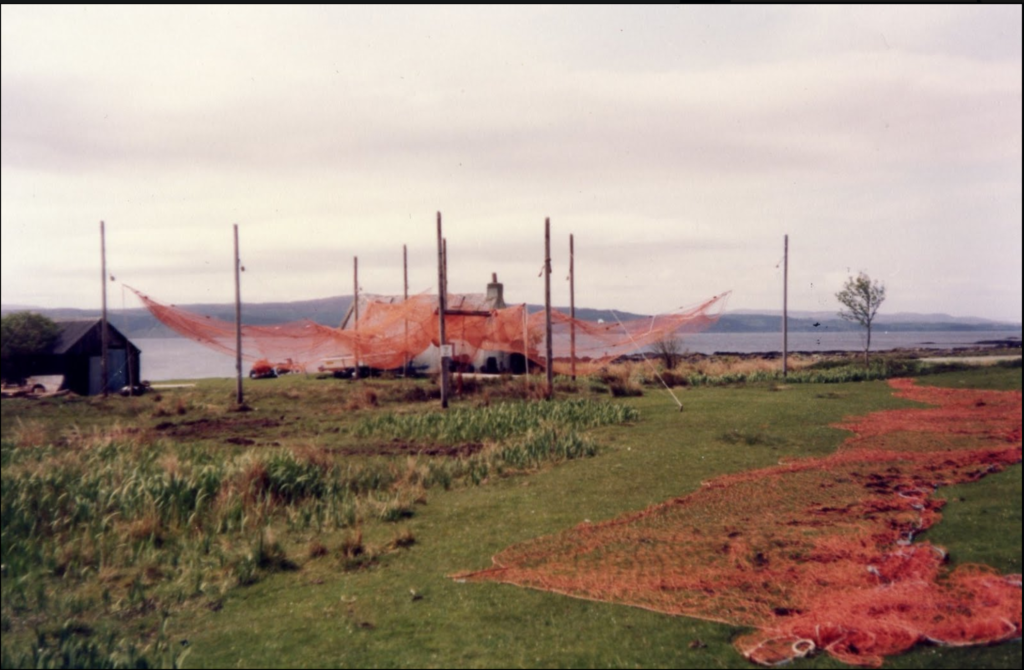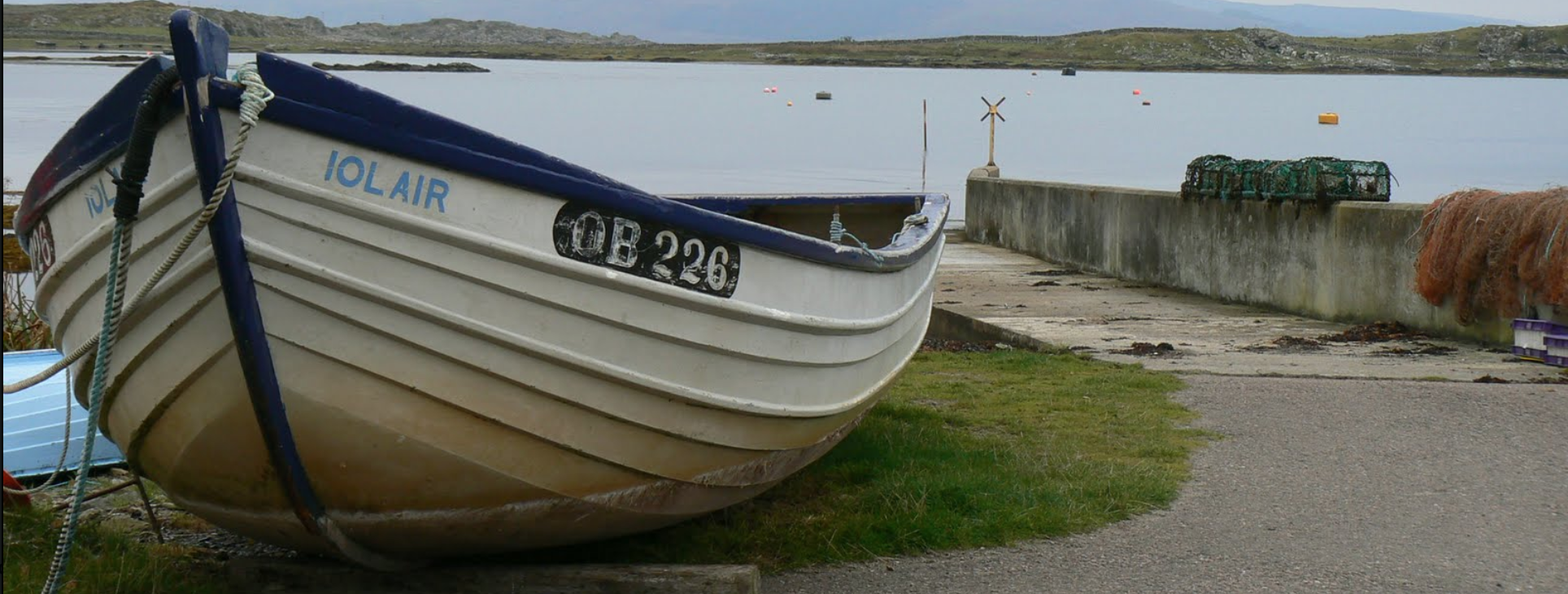The Kilchoan Station
If you are standing at the Kilchoan shop looking south towards Mull then the small white building behind and to your left was the bothy and the cottage down to your right was a boat house. There was a small black shed next to it and there are still one or two of the “dock poles” still standing. The fishings owned the ground the buildings stood on as well as the right to use the grassy area as a net green.

©Lorna Taylor˙
Photo 605
The Kilchoan boatshed
In the mid 1980s there were nine ‘dock poles’ on the Kilchoan net green arranged to provide two ‘docks’ where the ‘head’ part of the nets could be spread out for cleaning and mending. The nets could be hoisted on the poles, three to each side of the net, to allow the whole thing to be cleaned and inspected. Often time had to be spent repairing (unwanted) holes in the net. These could have been caused by seals bursting through the mesh in pursuit of a salmon or simply by wear and tear. It was good practice to drop the nets to the ground at the end of the working day: otherwise wandering sheep could get trapped within them.

©Lorna Taylor˙
Photo 600
The net green in Kilchoan with a bag net hanging from the “dock poles” The now demolished corrugated iron net shed is to the right: the boathouse/cottage just out of frame to the left
The Kilchoan station traditionally fished six nets: the most westerly, “Jib and Lug” being half way between Kilchoan and Ardnamurchan Point, the most easterly being ‘MacLean’s Nose’ at the mouth of Loch Sunart. In between there was ‘Rhu na Gall’, ‘The Twins’, ‘The Pier Net’ and ‘Mhile Burn’.
These net positions are shown on this page.

©Lorna Taylor˙
Photo 601
A salmon coble, OB209 leaving the Kilchoan Jetty in the mid 1980s, nets on board and crewed by Paul Taylor and Richard O’Connor
This boat is now in a shed by the ice house at Fascadale
In the Macleods’ first year at Fascadale, 1968 the Kilchoan station was fished. A salmon coble was kept on a mooring in the Kilchoan bay and a crew would come over from Fascadale to fish the nets on the south side.
In the early 1970s there was no sign of “dock poles” on the Kilchoan green so in the years just before that the dirty nets along with any fish caught must have been taken back to Fascadale.
The Macleods gave up fishing the Kilchoan station after one season. It can only be presumed that they felt the number of fish they got from it did not sufficiently repay their costs.

The Kilchoan Bothy in 2024
By the mid 1970s the Kilchoan Bothy, the little building to the east of the shop, was completely out of use and looking fairly derelict. The cottage in front and to the right of the shop was used as a boatshed. This building is a bit of a mystery: certainly it started out as a dwelling but at some stage was converted into a shed by having its seaward gable end opened to form a garage door.
In the later 1970s Alistair Maclean, an established fisherman from Tobermory took over the lease of the Kilchoan fishings. He bought a salmon coble, OB209, from the Macleods. He towed it from Fascadale to Tobermory where the boat was re-engined, given new floor boards and a new life.
It is unknown how many of the Kilchoan nets Maclean fished. It is a long way in a salmon coble to cross the Sound of Mull both ways each day and then fish nets from the west of Kilchoan down to Macleans Nose.
Alistair Maclean gave up the Kilchoan lease in 1982 with Paul Taylor taking it up in 1983. Taylor managed to buy Maclean’s salmon boat, OB209, returning the boat to Ardnamurchan. This is the boat now back at Fascadale.
The two remaining poles, ‘dock poles’ are what is left of the nine erected in 1983. The Southside Fishings were again to be fully fished from Kilchoan. The nets were hung on the green to be cleaned and repaired. The old bothy was not used but the cottage/boatshed was used as a shore base.

©Lorna Taylor˙
Photo 602
The old net shed (now demolished) on the green at Kilchoan with a bagnet hanging from the “dock poles” in the background and the net anchors in the foreground. The anchor buoys are attached ready for laying
Working the boat and the nets was easier at Kilchoan than at Fascadale. The old jetty had been rebuilt over the winter of 1982/3 by local volunteer labour. It provided a very useful landing place for dirty nets coming ashore and clean nets to be loaded onto the boat. Fortunately, the jetty was just wide enough to wheel a trailer down to the boat and then tow it back up and onto the green. A task that would take a crew of four at Fascadale could be managed by two people in Kilchoan.
The sea conditions on the south side of Ardnamurchan are more benign than on the north side. Very few days were lost to the weather. Kilchoan Bay however, where the salmon coble was moored is wide open to the south west wind and there is usually at least one southwest gale each summer. To make sure the boat was safe she had a very substantial ‘three anchor’ mooring. Two of the anchors were big net sized anchors.
The fish caught at Kilchoan were taken over to Fascadale to be weighed, iced and boxed.

Photo 603
Sadly the economic, political and environmental pressures that were coming to bear on the Scottish Salmon Netting Industry made the Kilchoan Fishings, as a stand alone enterprise unsustainable. The Taylors gave up the lease after two seasons.
For a more details on the ending of salmon netting click here
The last person to fish the Kilchoan Fishings was a local man Dochie Cameron: Dochie had worked at Fascadale many years previously.
By this time the Fishings were again owned by the Ardnamurchan Estate.
Dochie used the salmon coble OB226 ‘Iolair’.

Dochie Cameron, aboard OB 226 “Iolair” in Kilchoan Bay
